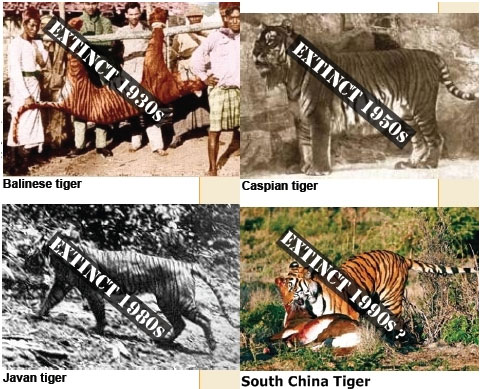There will be no tigers in Asia
According to a report by the World Wildlife Fund (WWF), the number of tigers in the Mekong basin, including Laos, Cambodia, Myanmar, Thailand and Vietnam, has been alarmingly reduced from 1,200 ( 1998) only about 350 children (2010).
The number of tigers plummeted in just over a decade
Compared to 1998, the number of tigers in 5 countries in the Mekong basin has decreased by more than 70%. This brings the world tiger population down to 3200 compared to 5000 children 10 years ago. The report said that the need to use tiger parts to serve traditional Chinese medicine is increasing and the tiger's natural habitat is broken in order to develop infrastructure. this decline.
The report was made during the Asian Ministers Ministers Meeting on Conservation of Tigers in Hua Hin, Thailand.

The number of tigers has decreased by more than 70% in more than a decade in the Mekong basin.
According to the WWF report, the total tiger population of the five countries in this region is only 350.
Photo: Malaysianinfocus.com
The tiger on the brink of extinction
Nick Cox, coordinator of the Mekong Basin Tiger Conservation Program, said: ' The definitive actions must be taken to ensure this Asian symbol continues to exist before it's too late. ' . He added: ' If we do not act now, tigers in Vietnam, Laos and Cambodia will be in danger of extinction in the next tiger year, ie 2022 '.

Count down to extinction. Photo: WWF.org
Ancient Middle Eastern tigers are found abundantly along the Mekong basin. However, today, the number of wild tigers is no more than 30 individuals in each country . The rest is mainly concentrated in the Kayah Karen Tenasserim range along the Thai and Myanmar borders.
Time remains to reverse the situation
Although the situation is happening in a negative direction, experts believe it is not too late to save the tiger that lives in the Mekong basin. This is the place with the highest area of tiger living in the world, about 540,000 km2, nearly the size of France, and is a priority for all efforts to preserve the tiger today.
' The tiger species in this area are capable of recovering only when countries are really trying to cooperate and implement on a large scale. In addition, activities to protect prey of tigers and ecosystems in general are also necessary , 'Cox said.
WWF requires governments to double the number of wild tigers by 2022
At the meeting, WWF asked the ministers of 13 countries with tigers to live to be responsible for doubling the number of tigers until 2022. These countries include Bangladesh, Butan, Cambodia, China, Indonesia, India. India, Laos, Myanmar, Nepal, Russia, Malaysia, Thailand and Vietnam.
The first Asian Ministers Meeting on Asian Species Conservation held from January 27 to 30 was part of the global political process to protect the tiger species in the future. These efforts were made during the Summit in Vladivostok, Russia in September. This conference was chaired by Russian Minister Vladimir Putin and co-organizer Robert Zoellick - president of the world bank.
' This is a great opportunity for countries to take action to reverse the situation, ' said Mike Baltzer, head of WWF's Global Tiger Protection Coalition. ' But to do this, they we must stop the trade of tiger parts, illegal hunting practices and protect the tiger's habitat . '
- How are predatory tigers?
- Tiger - lion: 'Hero of the moment'
- The Lord of the Forest is around the world
- Tigers are reviving in Asia
- Tigers find both heaven and hell in India
- Vietnam is one of 13 countries still living in tigers
- Legend of the tiger tiger U Minh
- Asia agreed to double the wild tiger
- The magnificent, magnificent tiger pictures of Siberia
- Fear for tigers in the year of tiger
- Four white tigers gave birth to four
- The United Nations is concerned about the survival of tigers
 Animal 'suffering' after hibernation
Animal 'suffering' after hibernation Why do goats climb well?
Why do goats climb well? Scientists were surprised to see chimpanzees eating turtles
Scientists were surprised to see chimpanzees eating turtles Giant catfish died deadly due to drought in Thailand
Giant catfish died deadly due to drought in Thailand